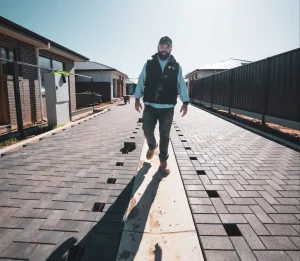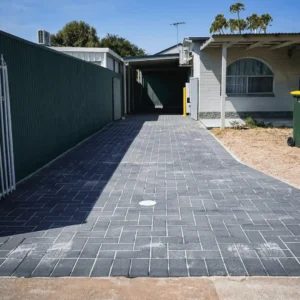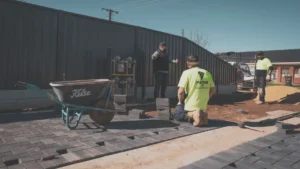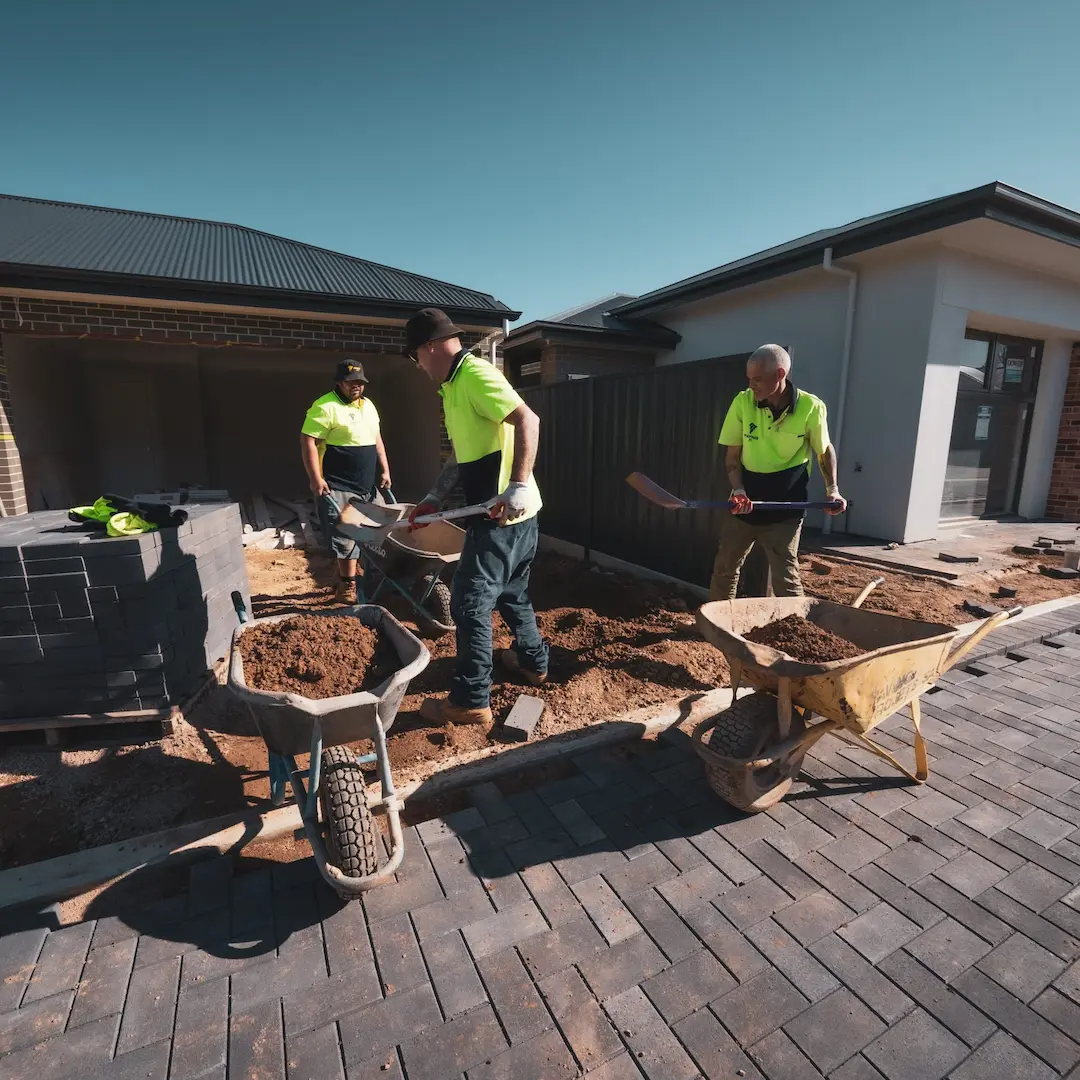Selecting the appropriate bricks for paving is vital to ensure both durability and visual appeal in constructing an inviting outdoor area. This guide explores the distinctive qualities of various bricks, evaluating aspects such as material composition, endurance, and aesthetic charm. Journey through selections of clay, concrete, and natural stone to determine the most suitable bricks for your paving project so that you can proceed with assurance.
Key Takeaways
- Selecting the right bricks for paving involves considering three main types: clay bricks, concrete pavers, and natural stone, each offering distinct aesthetic and functional benefits for different budgets and design preferences.
- Critical considerations when choosing paving materials include aesthetic appeal, durability, and maintenance requirements, ensuring the material’s lifespan and functionality align with the climate, usage, and personal lifestyle.
- The installation process for paving is integral to the durability and appearance of the pathway, with proper laying patterns, surface preparation, and edging all contributing to the stability and longevity of the paved area. Choosing a reliable paving contractor is vital to ensure your paving is installed correctly to stand the test of time. Furthermore, perfect paving placement will provide greater curb appeal and aesthetics. For those looking for the best paving contractors Adelaide has to offer, speak to our friendly team at Paving SA to schedule your free quote!
Types of Bricks for Paving
When choosing the ideal paving materials for your outdoor project, be it a driveway, patio paving or pathway, you have three primary options to weigh: clay bricks, concrete pavers and natural stone. Every one of these contenders has distinct characteristics that contribute both aesthetically and functionally to an outdoor area. Depending on whether you desire a traditional ambience or a contemporary style, recognizing the unique attributes of each material is key to creating not only an attractive but also a resilient exterior space.
Now let’s explore in detail what each type—clay brick, concrete paver and natural stone—has to offer so we can determine which may serve as the cornerstone for your forthcoming exterior venture.
Clay Bricks
Brick pavers made from clay embody a classic charm, offering an array of warm hues and textures that only kiln-fired clay can provide. This natural material’s endurance is fortified by the high-temperature firing process, which creates brick pavers known for their longevity and ability to retain colour without succumbing to fading.
Ideal for individuals who value durability along with a natural look, these bricks deliver not just a traditional paving option but one that persists through time while contributing to the distinctive appeal of any estate or property.
Concrete Pavers
Brick and concrete pavers present an unmatched array of design possibilities, with a wide range of shapes, textures, and colours at your disposal. Constructed from a blend of cement, aggregates, and colour pigments, these options for concrete paving can emulate various materials such as:
- Natural stone
- Brick
- Cobblestone
- Slate
All while offering a customizable and budget-friendly solution for paving needs.
For those aiming to customise their outdoor area to align with particular style preferences or visions, concrete pavers serve perfectly as the flexible material required. This option is poured concrete, which stands out as another potential choice due to its continuity and robustness when it comes to creating surfaces that last.
Natural Stone
Individuals aiming for a lavish flair will find that natural stone pavers serve as an exquisite selection, their prices fluctuating significantly depending on the specific stone chosen. The rich colours of sandstone to the refined gleam of granite span across a range of options that cater to different financial plans and aesthetic tastes.
Opting for the quaint allure of limestone or the sophisticated sheen of quartzite, natural stone pavers deliver a premium touch to each paving endeavour.
Factors to Consider When Choosing Bricks for Paving
Choosing the appropriate bricks for your paving project goes beyond visual appeal. It encompasses numerous essential factors that can affect both the durability and operational effectiveness of your paved space. Considering how local weather conditions can alter material characteristics, along with understanding the differing longevity and upkeep demands of potential paving choices, is crucial to making a well-informed selection.
We will delve into the pivotal aspects to consider which will steer you towards selecting bricks that are best suited for your specific requirements in paving.
Aesthetics
The aesthetic importance of paving is paramount. The choice of bricks significantly influences their visual appeal. A spectrum of options exists, from traditional red to avant-garde colour mixtures that match a variety of design sensibilities, ensuring the hue and texture can be either bold or blend seamlessly with existing landscape features.
Pavers go beyond mere practicality—they are integral elements in crafting an outdoor oasis. They empower you to fashion areas that aren’t just utilitarian but also reflect your individual taste and style preferences.
Durability
The endurance of a paving material is essential, as it underpins its longevity and resilience against various weather conditions. The appropriateness of pavers for distinct settings, ranging from peaceful patios to heavily used driveway paving, hinges on their density, capacity to prevent slips, and overall robustness. Notably in wet scenarios where safety is paramount, the natural slip-resistant properties of clay bricks provide an additional benefit.
In areas that experience considerable commercial footfall, the importance of durability escalates further. This is exemplified by the long-lasting brick construction found at Bellbowrie Pool in Queensland.
Maintenance
For homeowners, the level of maintenance is a crucial consideration and it differs greatly among various brick types. Minimal upkeep may be adequate for some bricks, involving just an easy rinse, whereas others necessitate consistent sealing to maintain their durability and aesthetic quality.
By taking into account the necessary maintenance from the beginning, you’re able to select a paving option that aligns with your way of life while keeping your outdoor area looking immaculate over time.
Installation Process and Techniques
Creating a durable and visually appealing pathway goes beyond using high-quality materials. It hinges on the meticulousness of the installation technique as well. The method of laying bricks has a significant impact on both the longevity and aesthetic value of the pavement. It’s essential to select appropriate patterns for laying, properly prepare the base surface, and execute finishing procedures meticulously to establish an enduringly stable and aesthetically pleasing paved area.
To ensure that your paving endures through time, let’s quickly consider each important phase in detail during installation — pausing just a few seconds at every step is vital. Once we pass this verification successful waiting checkpoint, we’re ready to advance to subsequent stages with confidence.
Laying Patterns
Choosing a laying pattern is not merely an aesthetic decision, but also one that influences the durability and solidity of the paved area. Intricate patterns such as herringbone and running bond are not only appealing to the eye but they bolster the connection among pavers, which is particularly beneficial for surfaces in high traffic zones.
Individuals who prefer a traditional appearance and desire an approachable DIY project might opt for less complex designs like basketweave or square configurations. These selections can help reduce the need for cutting while simplifying installation, all while fitting different shapes of pavers.
Surface Preparation
To ensure a paving project’s success, it is crucial to start beneath the surface. Establishing an even base through careful excavation helps avoid subsequent shifting or irregularities in the pavement. Incorporating a foundational layer of crushed rock or gravel is not only vital for structural stability, but also facilitates proper drainage of water, thus protecting your paved surface from potential water-related harm and prolonging its durability.
Edging and Finishing Touches
Edging serves as a critical yet often overlooked element in paving, establishing a distinct border to maintain the position of pavers. Concrete restraints applied along the edges effectively hinder the shifting of pavers, thus maintaining the integrity and enduring appeal of your paved design.
When joints between pavers are filled with polymeric sand, it not only solidifies their placement but also reduces weed proliferation. This helps to ease upkeep requirements while keeping your pavement’s aesthetic charm intact.
Cost Comparison: Brick vs. Other Paving Materials
When selecting paving materials, the cost frequently dominates the decision-making process. Evaluating and contrasting brick with other potential materials is essential for adhering to your budget while also realising your preferred results. Considering everything from upfront material costs to installation expenses and long-term value helps ensure that you make a financially savvy investment in your landscape.
We will explore the economic terrain of different paving options to ascertain which provides the most advantageous return on investment for your funds.
Material Costs
Your paving project’s total cost is greatly influenced by the initial price of raw materials. Concrete pavers are often less expensive than clay bricks, while natural stone constitutes a higher-end choice, thus your selection of material can markedly affect your budget. When deciding on pavers, bricks, concrete or stone for paving purposes, it’s vital to take into account not just their immediate expense, but also their durability and visual appeal over time.
Installation Costs
The overall expense of concrete paving projects is influenced not just by the cost of materials, but also by fluctuating labour rates and the complexity level of the installation. Depending on whether your project entails a straightforward pathway or an intricate driveway, there can be a significant variation in total costs.
Assessing these expenses before starting your project is crucial to avoid unexpected financial shocks as work progresses.
Long-Term Value
When evaluating the overall expense of paving, it’s not just about the upfront cost – one must think about long-term value as well. Clay bricks stand out for their extended lifespan that can reach hundreds of years, providing a more economically viable option in the long term when contrasted with concrete pavers which typically do not last as long.
Considering both durability and maintenance needs is essential to determine the total contribution each type of paving material will make to your property over time. This evaluation helps ensure you get lasting quality and value from either clay or concrete solutions used in your paving projects.
Environmental Impact of Brick Paving
At a time when environmental sustainability is of paramount importance, the ecological repercussions stemming from one’s choice in paving materials are critical and must not be overlooked. The utilisation of brick as a paving substance encompasses several environmental factors such as the depletion of natural resources and the carbon emissions produced during its manufacture. Permeable pavers have emerged, adding an innovative aspect to eco-conscious planning.
We should delve into assessing the ecological impact associated with brick pavements while seeking out alternatives that bolster our commitment to preserving a healthier Earth.
Resource Consumption
Manufacturing bricks, traditionally regarded as an artisanal practice, is increasingly challenged by sustainability issues due to the potential exhaustion of essential materials like clay. To address this issue and decrease carbon emissions simultaneously, the brick industry is shifting towards using alternative substances including recycled glass and fly ash. Air-cured bricks are part of these innovative solutions that align with environmental conservation efforts.
When selecting materials for your paving projects, mindful consideration of their resource impact enables you to select options that not only enhance your exterior design but also demonstrate ecological responsibility.
Carbon Footprint
The environmental impact of producing bricks, particularly the CO2 emissions resulting from kiln firing, is considerable and should not be overlooked. Clay bricks often have a lower carbon footprint than their concrete counterparts because they are composed of natural materials and require less energy to produce. There remains an ecological price attached to their manufacture.
Recognizing this effect is crucial for individuals who aim to make environmentally responsible choices when undertaking paving initiatives.
Permeable Paver Options
At the vanguard of eco-conscious paving options are permeable pavers. These materials excel in water management as they facilitate the seepage of rainwater back into the earth, aiding in groundwater replenishment and easing pressure on stormwater infrastructure.
By utilising waste products within their composition, permeable pavers can minimise energy use and cut down on greenhouse gas emissions. This makes them a compelling choice for those seeking environmentally responsible paving solutions.
Case Studies: Successful Brick Paving Projects
Evidently, the true test of paving quality comes from its performance underfoot, a testament to the many successful brick paving endeavours across the world. Brick has established itself as a superior choice for various applications ranging from residential driveways to vast commercial plazas due to its blend of visual appeal and practicality. These instances showcase not just the adaptability inherent in brick materials, but also serve as creative catalysts for future undertakings.
We should examine specific instances where brick paving has been used effectively, resulting in durable and visually striking exteriors.
Driveways
The materials used for driveways must endure the constant activity of daily use since they serve as the primary entrance to your residence. Opting for herringbone patterns in driveway designs has not only enhanced their practicality, but also elevated the aesthetic appeal, as evidenced by the makeover of a suburban property.
Incorporating interlocking concrete pavers into a sloped residence’s design resulted in improved traction on inclined surfaces, marrying utility with architectural elegance. For homes near coastlines grappling with drainage challenges, permeable pavers have emerged as an effective and eco-friendly option that addresses these concerns while maintaining functionality.
Patios and Walkways
The attractive and long-lasting characteristics of brick materials make them an ideal choice for constructing patios and walkways. Consider the tranquil haven created by installing a basket weave-pattern brick patio in the backyard of a historic house, which amplified its enchanting allure. Employing locally sourced clay bricks for creating walkways within a rural estate offered not only breathtaking visual links among garden elements but also upheld ecological balance.
Such undertakings demonstrate the remarkable potential of carefully selected pavers to enhance both recreational pleasure and aesthetic appeal in outdoor spaces.
Commercial Spaces
Pavers made from brick are a top choice for both residential and commercial applications, demonstrating remarkable resilience in areas with heavy use. The enduring nature of brick pathways and plazas that date back to the early 1900s serves as evidence of their ability to withstand busy environments. These bricks maintain their structural integrity under the dense pedestrian activity found in shopping centres while also enhancing the visual charm that attracts patrons.
Opting for commercial-grade brick pavers is an intelligent decision for enterprises aiming to blend functionality with aesthetics due to their minimal maintenance needs.
Summary
In summary, navigating the realm of paving has revealed the intricacies involved in selecting an appropriate material, mastering installation techniques, and considering both cost and environmental impacts. Choosing between clay’s classic allure, concrete’s adaptability or natural stone’s opulence will pave the way toward a resilient and fashionable exterior area. Equipped with deep insights into these elements, you possess all that is necessary to pick out ideal stones or bricks for your project—forging walkways destined to be cherished across ages.
Frequently Asked Questions
How do I choose between clay bricks and concrete pavers for my driveway?
Take into account your desired aesthetics, the longevity of the material, and upkeep needs. Concrete pavers afford you design versatility with less maintenance involved, whereas clay bricks give a timeless appearance and boast considerable durability but might require greater care. Make your selection according to what suits your specific requirements best.
Can brick pavers be used for high-traffic areas like commercial spaces?
Certainly, pavers made of brick are well-suited for areas with high pedestrian traffic in commercial settings because of their robustness and appropriateness for such uses. It is especially advisable to employ herringbone patterns when installing these brick pavers.
What are the environmental benefits of using permeable pavers?
Permeable pavers contribute to environmental advantages by promoting groundwater replenishment, diminishing flood risks, and easing the burden on stormwater infrastructure as they permit rainwater to seep into the earth.
Are there any cost-effective alternatives to natural stone pavers?
Indeed, pavers made from concrete have the ability to mimic the look of natural stone while being a less expensive option, offering an economical solution along with a diverse array of design selections.
How long do brick pavers last compared to concrete pavers?
Consider opting for brick pavers if you are seeking both durability and extended lifespan. These pavers have the potential to endure anywhere from 25 up to a century, which notably surpasses the approximate 25-year life expectancy of concrete pavers.




